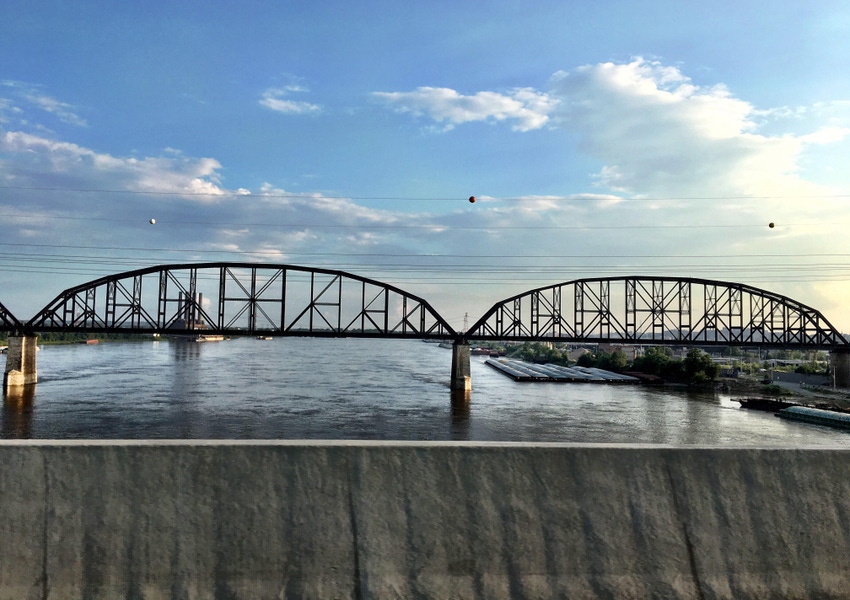Farmers offer $1M to move lock and dam project
Goal is to move lock and dam project “From the On-Deck Circle to the Batter’s Box”.
November 30, 2021

In the effort to encourage tangible investment in the infrastructure along the Upper Mississippi River, a group of farmer-funded and farmer-led organizations – the United Soybean Board, the Soy Transportation Coalition, the Illinois Soybean Association, the Iowa Soybean Association, the Iowa Corn Promotion Board, the Minnesota Soybean Research and Promotion Council, and the Missouri Soybean Merchandising Council – have partnered together and offered $1 million to help underwrite the cost of pre-engineering and design expenses of Lock and Dam #25.
The contribution is contingent upon the Army Corps of Engineers, the government agency responsible for maintaining locks and dams, being able to accept funding from private sector entities for such projects.
Located in Winfield, Mo., Lock and Dam #25 was opened in 1939 and is the most southern lock and dam on the Mississippi River with a single, 600 ft. X 110 ft. lock chamber. Most every bushel of soybeans, corn, and other grain transported along the Mississippi River from the states of Illinois, Iowa, Minnesota, Missouri, and Wisconsin will pass through Lock and Dam #25 en route to export facilities near the Gulf of Mexico.
If Lock and Dam #25 proceeds to construction, it would be the first construction project within the Navigation and Ecosystem Sustainability Program (NESP). The NESP program calls for the construction of seven new locks – five north of St. Louis on the Upper Mississippi River (#25, #24, #22, #21, and #20) and two on the Illinois River (LaGrange and Peoria). Construction at Lock and Dam #25 would result in a new 1,200 ft. X 110 ft. lock chamber being built adjacent to the existing 600 ft. X 110 ft. lock chamber. This would enable a typical 15 barge tow – transporting over 800,000 bushels of soybeans – to transit the lock in one single pass (a 30-45 minute process) compared to disassembling the barge tow into two sections, which will result in two passes (over two hours). In addition, a second lock will provide needed resiliency and redundancy – allowing a key link in the supply chain to remain operational if one of the lock chambers was closed.
The profitability of the American farmer is not just a function of creating supply or of generating demand but it is also a function of having sufficient connectivity between supply and demand. The multi-modal system of roads and bridges, freight railroads, inland waterways, and ports allows farmers located in the middle of the country to be able to access customers around the world. Unfortunately, a key link in the agricultural supply chain – the locks and dams along the nation’s navigable waterways – has long been the victim of funding intentions not resulting in funding outcomes. As a result, many of the locks and dams – particularly along the Upper Mississippi River – do not provide the efficiency and resiliency that 21st century agriculture requires.
“Other nations have inland waterways,” says Jonathan Miller, a soybean farmer from Island, Kentucky, and chairman of the Soy Transportation Coalition. “However, one of the reasons our inland waterways are so unique is that they are adjacent to some of the most productive farmland on the planet. As a result, many farmers throughout the country have close access to a marine highway that can effectively transport soybeans, grain, and other commodities to export terminals, which allows us to be so competitive. It is therefore critical that our nation commits to the necessary investments to maintain and improve this important part of our supply chain.”
“Many of these critical lock and dam projects along the Upper Mississippi River region have lingered for years – perpetually waiting for the necessary funding to increase their capacity and resilience,” explains Mike Steenhoek, executive director of the Soy Transportation Coalition. “Farmers and other stakeholders believe it is time for Lock and Dam #25 and other priority projects to finally move from the on-deck circle to the batter’s box.”
The current project to deepen the lower Mississippi River has provided a successful template for farmer funding being used to facilitate infrastructure projects. For the deepening project, soybean farmers worked with leaders and stakeholders in Louisiana to promote this key export region for soybeans and grain. The United Soybean Board contributed $2 million to help underwrite the pre-engineering, design, and analysis costs of the project. Because of this successful partnership, farmers have expressed a desire to invest additional funds to help encourage further momentum on other key infrastructure projects – resulting in the initiative to promote Lock and Dam #25.
“Because of all the work over the years by a variety of agricultural leaders, the barge and towing industry, and so many other inland waterways stakeholders, we are on the cusp of achieving tangible results for a number of these important projects on the Upper Mississippi River,” explains Steenhoek. “The team of inland waterways stakeholders are all working to ensure Lock and Dam #25 and other lock and dam projects will become a reality in the near future. The $1 million offer by farmers is a supplement to this overall effort. With the finish line in sight, farmers and other stakeholders truly want to run through the tape.”
Established in 2007, the Soy Transportation Coalition is comprised of thirteen state soybean boards, the American Soybean Association, and the United Soybean Board. The goal of the organization is to position the soybean industry to benefit from a transportation system that delivers cost effective, reliable, and competitive service.
SOURCE: Soy Transportation Coalition
You May Also Like



